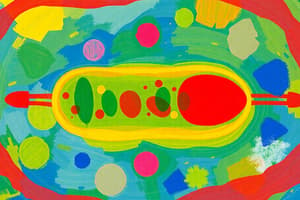Podcast
Questions and Answers
What is the primary method by which oxygen is transported in the blood?
What is the primary method by which oxygen is transported in the blood?
Most O2 is transported by hemoglobin as oxyhemoglobin (Hb—O2) within red blood cells.
How much O2 is dissolved in blood plasma?
How much O2 is dissolved in blood plasma?
About 1.5% of inhaled O2 is dissolved in blood plasma.
What is oxyhemoglobin?
What is oxyhemoglobin?
Oxyhemoglobin is formed when oxygen binds to hemoglobin.
What determines how much O2 binds to hemoglobin?
What determines how much O2 binds to hemoglobin?
What is the oxygen-hemoglobin dissociation curve?
What is the oxygen-hemoglobin dissociation curve?
How much oxygen binds to hemoglobin in pulmonary capillaries?
How much oxygen binds to hemoglobin in pulmonary capillaries?
How much oxygen binds to hemoglobin in tissue capillaries?
How much oxygen binds to hemoglobin in tissue capillaries?
What happens to hemoglobin's affinity for oxygen during exercise?
What happens to hemoglobin's affinity for oxygen during exercise?
Is O2 more or less available to tissue cells when you have a fever?
Is O2 more or less available to tissue cells when you have a fever?
How does acidity (pH) affect oxygen unloading from hemoglobin?
How does acidity (pH) affect oxygen unloading from hemoglobin?
What is BPG and its effect on hemoglobin?
What is BPG and its effect on hemoglobin?
What is the effect of temperature on hemoglobin's release of O2?
What is the effect of temperature on hemoglobin's release of O2?
What is the relationship between PO2 and CO2 binding to hemoglobin?
What is the relationship between PO2 and CO2 binding to hemoglobin?
How does the affinity of hemoglobin for O2 change during exercise?
How does the affinity of hemoglobin for O2 change during exercise?
What happens to blood saturation levels of CO2 when jogging?
What happens to blood saturation levels of CO2 when jogging?
Flashcards are hidden until you start studying
Study Notes
Oxygen Transport
- Oxygen is poorly soluble in water; only 1.5% is dissolved in blood plasma.
- 98.5% of blood oxygen is bound to hemoglobin within red blood cells.
- Each 100 mL of oxygenated blood contains about 20 mL of gaseous O2.
Oxygen and Carbon Dioxide Transport Mechanisms
- Most O2 is transported as oxyhemoglobin (Hb—O2) in red blood cells.
- Most CO2 is transported as bicarbonate ions (HCO3-) in blood plasma.
Oxyhemoglobin
- Hemoglobin contains a heme group with four iron atoms, each binding to one O2 molecule.
- The binding of oxygen to hemoglobin is a reversible reaction.
Hemoglobin Relationship with Oxygen Partial Pressure (PO2)
- PO2 is the primary determinant for the amount of O2 that binds to hemoglobin.
- Higher PO2 levels result in greater O2 binding to hemoglobin.
Saturation States
- Fully saturated hemoglobin means all hemoglobin has converted to oxyhemoglobin.
- Partially saturated hemoglobin consists of a mix of hemoglobin and O2.
Oxygen-Hemoglobin Dissociation Curve
- This curve illustrates the relationship between hemoglobin saturation and O2 levels.
- High PO2 results in nearly 100% saturation of hemoglobin, while low PO2 leads to partial saturation.
- Increased PO2 promotes more O2 binding to hemoglobin until all binding sites are occupied.
Oxygen Binding in Capillaries
- In pulmonary capillaries, high PO2 allows significant O2 binding to hemoglobin.
- In tissue capillaries, lower PO2 results in reduced O2 binding.
Carbon Dioxide and Hemoglobin Interaction
- As PO2 increases, more CO2 binds to hemoglobin.
Pulmonary Veins Saturation
- Regardless of exercise, hemoglobin in pulmonary veins remains fully saturated with CO2.
Factors Affecting Hemoglobin's Oxygen Affinity
- Besides PO2, acidity (pH) influences hemoglobin's oxygen binding capacity.
Acidity (pH) Effects
- Increased acidity facilitates oxygen unloading from hemoglobin.
- Lactic acid and carbonic acid are the main acids from active tissues.
Influence of Carbon Dioxide Partial Pressure
- CO2 can also bind to hemoglobin, mimicking H+ effects and shifting the binding curve to the right.
Temperature Effects
- Elevated temperatures generally increase oxygen release from hemoglobin.
Role of BPG (2,3-bisphosphoglycerate)
- BPG decreases hemoglobin's affinity for O2, promoting oxygen release.
Affinity Changes with pH and CO2 Levels
- Increased CO2 levels or decreased pH reduce hemoglobin's affinity for CO2, allowing more O2 for tissue use.
Hemoglobin Affinity During Exercise
- During exercise, lactic acid and CO2 generation lowers blood pH and raises PCO2, reducing hemoglobin affinity for CO2; thus, more O2 is available for active muscles.
Oxygen Availability During Fever
- During fever, O2 becomes more accessible to tissue cells due to decreased hemoglobin affinity for CO2 with increased temperature.
Carbon Dioxide Transport Details
- A resting person has about 53 mL of gaseous CO2 per 100 mL of blood.
Studying That Suits You
Use AI to generate personalized quizzes and flashcards to suit your learning preferences.




